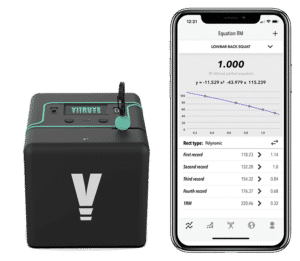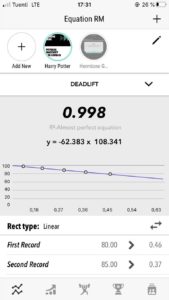17 de June de 2020
What’s Velocity-Based Training?
Velocity Based Training (VBT) is a fantastic tool for coaches and strength and conditioning professionals all around the world. VBT is a modality of training which requires an athlete to have their speed of movement measured. This is usually done under the forms of conventional barbell lifts but this can also progress to jumps and more specific training modalities. The fundamental premise of VBT is that speed is measured and multiple metrics or descriptive statistics are produced which provide coaches with information to determine transfer of training, auto-regulation, and or make adjustments to training. There is an extensive array of possibilities of VBT.
Throughout this article, I will be introducing VBT to you and discussing what it is and how you can go about it into your training right away. We will be covering auto-regulation, feedback, optimal load, and force-velocity profiling. This is an introductory post to which later articles will draw more in-depth attention and analysis towards these areas.
Coaching mistakes
When we look at auto-regulation within training we are referring to a volume management system which is used to regulate an individual’s work capacity of which we can apply training stimulus. VBT allows us as coaches to train the individual needs of athletes regularly and make significant adjustments very quickly. One of the common mistakes made within coaching is that we use arbitrary percentages of one repetition max. This does not fairly represent the athlete’s current state of readiness to train which then can cause a significant problem with regards to the management and the training appropriateness.
As coaches our job is to progress our athletes in accordance to the development of their sport at a safe and consumable rate
It is really important to understand that every athlete will progress at their own rate and it is our job as coaches to ensure that this progression happens at a safe and sustainable rate. This allows an athlete to optimize their time within the gym or on the field. We as coaches do not want to interfere with the individual athlete’s progress too much as we will actually slow down their rate of development if we provide too much volume or either intensity. With tools such as VBT we can avoid these problems because we are providing real-time accuracy through the varying means of feedback of which VBT provides. Ultimately we are trying to not overtrain or overreach our athletes too far because we will increase the risk of injury very significantly and slow down the rate of change. As coaches our job is to progress our athletes in accordance to the development of their sport at a safe and consumable rate.
Stress
Auto-regulation will also help account for other stresses in an athlete’s life. It has well been documented that the general adaptation syndrome theories pay specific attention towards the stress that is accumulated through all mediums of life, not just those that have been placed upon an athlete through resistance training or sport practice. Again paying great respect towards the effectiveness of measuring the velocity of a bar as opposed to the absolute load lifted. If a person is highly stressed and overly tired they will be able to demonstrate this very quickly under a certain percentage of the load. With this, a coach will be able to make a rapid change to the load lifted still to achieve the desired result. This is going to allow the athlete to do a couple of things, one being that they are able to still produce a certain to the amount of velocity thus creating a relative level of stimulus and two being able to unload the stress of the system creating less mechanical torque and joint compression forces. This allows the athlete to adapt.
How we manage the training process with VBT and deem the most specific accuracy for the individual is by creating a velocity profile. Within the next section of this article I’m going to explain to you what a velocity profile is .
Velocity Profile
A velocity profile simply is the speed at which you are able to move a certain percentage of your one repetition max. The advice given is to create a velocity profile is a logical progression in certain percentages of one repetition max for a given lift. This could be anywhere from 3 to 6 measurements of velocity. For example you could use 20, 40, 60, 80, 90, percent of 1 RM. This would give you a very even spread of velocity and allow you to plot a load velocity relationship. Again it is important to note that the relationships between loads of percentage of one repetition Max and velocity vary between athletes and between different lifts.
When you know your velocity profile you can assign certain velocities that you would move a given percentage for rather than focusing on the percentage of one repetition Max. For example, if I moved 65% at rough naught 0.75 m/s anytime that I had 65% I would assign 0.75m/s for the load intensity. This will automatically manage the training stress accordingly. Also, you may utilize the daily slope with a specific velocity to assign the percentages of one repetition Max. It is incredibly important to understand the relationship and how it varies by exercise as it is imperative that you correctly select the most appropriate load. With VBT you have a more specific metric to track as you or measuring speed as opposed to absolute load.
Load-Velocity profile of Deadlift (Vitruve TEAMS app)
Velocity profiles whilst incredibly accurate can come with a few downsides, one of which is when you are trying to implement velocity profiles with large numbers of athletes. For example in some settings you could be working with up to 50 to 100 athletes at a time in a gym. As you can see just by that sheer number alone there are a lot of people to manage. Now try and produce individual profiles per athlete and trained to them specifically every session. This is going to become incredibly time consuming and also provide a lot of non essential destructions to training. This is where velocity zones become incredibly reliable. The use of zones such as boscos strength continuum as seen in the image below is a great way and a highly effective strategy for the development of large numbers of athletes.

For me as a coach, I do like the use of velocity zones as it allows an athlete to work within a bandwidth. If we were being highly specific to certain measurements then we would be changing load on the bar continually, as Rep to Rep variance is highly likely within a training environment. Athletes are not robots, so therefore we should not assume that they will train like 1. Velocity zones are also a fantastic tool when we are considering the impact of feedback to an athlete.
VBT benefits
A huge benefit of VBT is its ability to provide real-time feedback to an athlete within a training session. As coaches, we could target metrics such as peak power, peak velocity, mean power, mean velocity, just to name a few. What this is going to do is demonstrate to an athlete when there needs to be more intent placed under the bar to achieve the highest score possible or change the load on the bar which will optimize the best score possible.
What this does provide is a strong associative learning paradigm towards the constructs of psychological feedback loops. This falls within the psychology of operant conditioning which in itself will drive the success of your program because you are continually able to provide a high sense of reward to your athletes. Irrespective of the load that they have on the bar they are always going to be achieving.
For later posts around this subject, we will then learn to understand the impact of which using lighter loads and focusing on speeds and powers will actually create changes in the muscle structures of athletes and transfer greater to sport-specific activities and health. What we do know it as as an external focus to increase performance. We will make the intention of the movement incredibly clear, and then the athletes will always be able to see the results as a consequence of a much more focused attention as the measurement of speed is purely objective it doesn’t know who the athletes are the objectivity of this, therefore, creates a clear path to success. For example, if an athlete is supposed to be moving the bar at 1.0 m/s and the reading on the screen instantaneously demonstrates to them that they are moving at 0.75 m/s, then what this dove is automatically coach the intent into the athlete or you.
The number of times as a coach (if you’re reading this you must agree with me) that we do spend too much time motivating our athletes to lift. All-time is better spent in communicating weather athletes and managing the process of coaching as opposed to creating verbal encouragement. Why don’t we allow machines to do that for us and save our voices?
 Vitruve encoder and Vitruve app
Vitruve encoder and Vitruve app
That concludes this introduction to velocity-based training. If you have any questions regarding this feel free to reach out to us further through the contact forms
#VBTforYou
References
Mann, B., Kazadi, K., Pirrung, E., & Jensen, J. (2016). Developing explosive athletes: Use of velocity based training in athletes. Muskegon Heights, MI: Ultimate Athlete Concepts.


